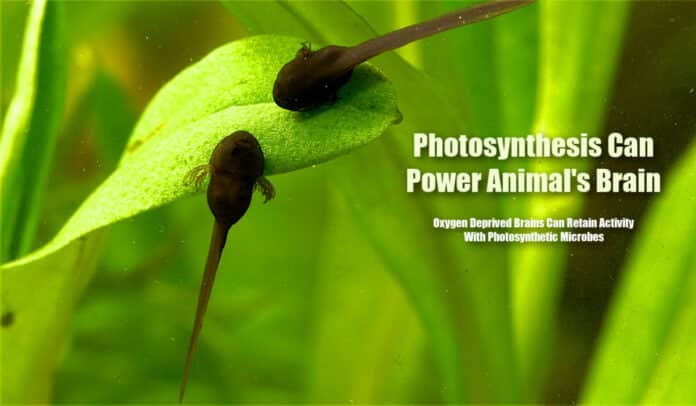Photosynthesis Powered Brain Can Retain Function In Oxygen Deprived Conditions
Compared to plants, animals cannot perform photosynthesis to produce their own oxygen. However, animals’ brains depend on oxygen to generate large amounts of energy required to carry out a function. In a research article issued in iScience, scientists discovered a means to use photosynthesis to provide oxygen for neurons. Xenopus laevis tadpoles were introduced with either green algae or cyanobacteria and were kept in an anoxic environment, enabling the stoppage of brain activity. When these animals were exposed to light, the introduced microbes were able to produce oxygen from carbon dioxide and restore neural activity.
Diana Martinez, a neuroscientist, Rowan University, New Jersey, who did not participate in the research wrote in an email to The Scientist that the writers use an easily reproducible and sophisticated experimental method to study the impact of triggering photosynthetic organisms as a means to directly elevate the level of oxygen within the brain. She added that the study is proof of concept and is a crucial first step in employing natural materials to tackle pathological conditions that lower the oxygen levels within the brain such as stroke and heart attack.
Hans Straka, a neuroscientist at LMU (Ludwig Maximilian University), Munich, and his team were curious about the oxygen usage within the brain and employed an approved method in which they separated the tadpole’s head and kept it functional & alive for a few days in a liquid medium having nutrients and oxygen. Jörg Nickelsen, a plant biologist at LMU, and Straka came up with a project proposal. They decided to study if it could be possible to employ photosynthetic microbes to provide oxygen for the brain.

Myra Chávez Rosas, Nickelsen’s then-postdoc, who is currently working at the University of Bern, Switzerland, cultured cyanobacteria (Synechocystis sp. PCC6803) and green algae (Chlamydomonas reinhardtii). Both of these microbes produced oxygen when exposed to light. Suzan Özugur, a former student who worked for the project, introduced a mix of either cyanobacteria or algae inside the tadpole’s hearts right after the emergence of their forelimbs. Microorganisms were pumped by their hearts to their vessels, including the brain’s vasculature.
The group discovered that upon exposure to light, oxygen levels within the ventricles of the experimented animals increased. Animals without any light exposure or untreated cyanobacteria or algae that were genetically manipulated to not make oxygen didn’t have any change in oxygen levels. When scientists decreased the oxygen concentration within the water medium, neuronal activity quantified by the representative nerves’ electrical recordings stopped. However, they were capable of restarting the brain activity by exposing animals who were introduced with microbes to light. The activity of neurons stopped when the light exposure was turned off.
Even though the study was successful, Martinez observes that it is not evident if the findings can be used to address the impairments during which the brain is deprived of oxygen. She stated that since Xenopus laevis tadpoles are transparent, light permeability via the skin is easier and the photosynthetic system gets activated to make oxygen. This was one of the major issues. Another aspect was that employing complex animals posed difficulty since light permeability via the skin is poor and therefore might not reach the vasculature to turn on photosynthetic organisms. Moreover, while reduced levels of oxygen can be an issue, surplus oxygen can also worsen the brain. She further mentioned that the inefficiency of oxygen level maintenance via the usage of these photosynthetic microbes will hence be just as dangerous as hypoxia. Attempting the method in the slices and brain organoids initially would offer more information about its physiological effects.
Straka admitted that the study concerning the photosynthesis-powered brain is still at the preliminary phase and clinical trials are yet to go. He said that his group will concentrate on many questions like can tadpoles utilize the sugar produced by microorganisms and what are the immunological effects of subjecting photosynthetic microbes.
Ryan Kerney, a biologist working at Gettysburg College, Pennsylvania, whose study is about symbioses between salamanders and algae and who didn’t involve in the study expressed that for the past decade, there were some studies where researchers have been attempting to create artificial symbiotic relationships with algae to manipulate or magnify the physiology of vertebrate, which is in fact progressive. Kerney mentioned that methods, where microorganisms are artificially introduced into tissues or cells to alter their role, are mainly under-scrutinized and unregulated when compared to the extensively employed genetic engineering techniques like CRISPR that focus on a single gene. He noted that the examples of pathogenic algae and the unknowns make this method somewhat challenging. However, the possible effects are even interesting to discuss: Could we escape from breathing as a means to keep our brain’s function intact?
Photosynthesis Powered Brain



